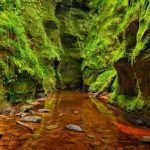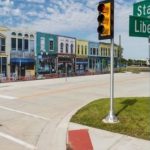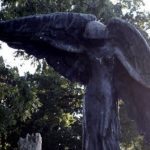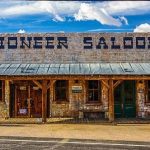 Creepy
Creepy  Creepy
Creepy  Technology
Technology 10 Scientific Breakthroughs of 2025 That’ll Change Everything
 Our World
Our World 10 Ways Icelandic Culture Makes Other Countries Look Boring
 Misconceptions
Misconceptions 10 Common Misconceptions About the Victorian Era
 Mysteries
Mysteries 10 Strange Unexplained Mysteries of 2025
 Miscellaneous
Miscellaneous 10 of History’s Most Bell-Ringing Finishing Moves
 History
History 10 Great Escapes That Ended Right Back in Captivity
 Weird Stuff
Weird Stuff 10 Fascinating Things You Might Not Know About Spiders
 Food
Food 10 Everyday Foods You Didn’t Know Were Invented by the U.S. Military
 History
History 10 Odd Things Colonial Americans Kept at Home
 Creepy
Creepy 10 More Representations of Death from Myth, Legend, and Folktale
 Technology
Technology 10 Scientific Breakthroughs of 2025 That’ll Change Everything
 Our World
Our World 10 Ways Icelandic Culture Makes Other Countries Look Boring
Who's Behind Listverse?

Jamie Frater
Head Editor
Jamie founded Listverse due to an insatiable desire to share fascinating, obscure, and bizarre facts. He has been a guest speaker on numerous national radio and television stations and is a five time published author.
More About Us Misconceptions
Misconceptions 10 Common Misconceptions About the Victorian Era
 Mysteries
Mysteries 10 Strange Unexplained Mysteries of 2025
 Miscellaneous
Miscellaneous 10 of History’s Most Bell-Ringing Finishing Moves
 History
History 10 Great Escapes That Ended Right Back in Captivity
 Weird Stuff
Weird Stuff 10 Fascinating Things You Might Not Know About Spiders
 Food
Food 10 Everyday Foods You Didn’t Know Were Invented by the U.S. Military
 History
History 10 Odd Things Colonial Americans Kept at Home
10 Christmas Towns Whose Name Has Nothing to Do with the Holiday
According to information from the United States Census Bureau, there are 29 cities and towns across America with names that embody the spirit of Christmas. For example, nestled in the Adirondack Mountains is the small town of North Pole, New York, where Christmas never ends. The town is home to Santa’s Workshop, one of the first American theme parks, complete with various attractions—rides, a carousel, and even real reindeer—all of which are dedicated to keeping the Christmas spirit alive year-round.
This list, however, focuses on cities and towns that, despite their festive namesake, have a history that, ironically, has nothing to do with Christmas. From names dedicated to the first Caucasian male born in the village to a Mormon settlement whose name is a combination of two church members to a name picked solely on luring tourists to a pecan farm to a town named due to an error, these ten Christmas- and winter-named cities, towns, and villages were named for various reasons, none of which have to do with the December holiday or the winter season.
Related: Top 10 Attractions To Visit For A Weird Tour Of Europe
10 Rudolph, Wisconsin
Incorporated in 1960, Rudolph, Wisconsin, was the second town to be established in Wood County and is located approximately 7 miles (11 km) north of Wisconsin Rapids. The tiny village is home to just 432 residents but is known as one of the best dairy areas in Wisconsin. In fact, Dairy State Cheese, a retail store and production facility, has been operating in Rudolph for more than 70 years and boasts over 200 varieties of Wisconsin cheese. Additionally, Rudolph is known as the “Home of the Famous Grotto Shrine and Wonder Cave.”
Father Phillip Wagner was studying for the priesthood in Europe in 1912, but unfortunately, his health was failing. Therefore, Father Wagner visited Our Lady’s Shrine in Lourdes, France—which is well-known for healing—and made a promise to the Virgin Mary that, if his health was restored, which would allow him to be ordained, he would build a shrine in her honor someday.
Father Wagner’s condition slowly improved, and his strength returned, allowing him to be ordained in 1915. The Rudolph Grotto was started in the 1920s as a fulfillment of that promise. The Grotto—a spiritual oasis—now spans over 5 acres (2 hectares), contains lush flower beds, numerous shrines, a museum, and a gift shop; it attracts approximately 30,000 visitors each year.
Just as the village’s name suggests, Santa’s famous reindeer is highly regarded in Rudolph. Street signs in the community have a picture of the red-nosed reindeer, the post office has a special reindeer stamp that can be imprinted on outgoing mail, and the annual Rudolph County Christmas features a wide variety of events—a live nativity, Belgian horse and wagon rides, cookie decorating, storytelling, a craft sale, train rides, and a lighted Christmas parade featuring Santa and his sleigh—just to name a few.
However, despite all the Christmas and reindeer-themed fun within the village, it wasn’t named because of Santa’s reindeer at all. In fact, the village of Rudolph was named after Rudolph Hecox, the first Caucasian male born in the town in the 1850s.[1]
9 Snowflake, Arizona
While the state of Arizona is known for its cactuses, heat, and deserts, it is also home to a town named Snowflake. However, despite a name that sounds like a winter wonderland, Snowflake is not very snowy at all, receiving only about 13 inches (33cm) of snow for the entire year. Although its name isn’t tied to Christmas or the winter staple, the history of Snowflake, Arizona, and its name is chock full of unique, religious history.
The town of Snowflake has a population of approximately 7,000 residents and rests in Arizona’s White Mountains, between Holbrook and Show Low. However, Snowflake’s history dates all the way back to 1878. In the late 1870s, a land agent named William J. Flake and five other families were among the numerous individuals sent by Bringham Young of the Church of Jesus Christ of Latter-day Saints to establish Mormon colonies throughout the southwest. At that time, however, Arizona was just a U.S. territory rather than a state.
After selling his land in Beaver, Utah, Flake and his pioneer companions obeyed the command given by Young, and upon arriving in the Little Colorado Valley, they established the settlements of Ballinger’s Camp, Sunset, Old Taylor, and Allen’s Camp. However, the hostile environment and the difficulty of living the standards set by the “United Order”—a church movement that called for a collectivist, communal living—led Flake to look for a place to build a new settlement. Specifically, Flake was looking to settle on Silver Creek, a 45-mile-long (72-km) stream located in the White Mountains.
Unfortunately, the 300-acre (12-hectare) area was owned by a rancher named James Stinson. Stinson agreed to sell his land for $12,000, but after negotiating, Flake was able to get the price reduced to $11,000 in cash. Flake then raised the money by convincing church leaders to procure the sale of cattle from their Utah ranches. On July 21, 1878, Flake and other pioneer families moved onto the ranch.
On September 24, 1878, Flake met with Mormon Apostle Erastus Snow, who was dedicating the new Mormon colonies. While some settlers wanted to name the town after Snow, and some wanted to name it after Flake, it was later decided that the settlement would be called Snowflake, a combination of the two men’s last names.[2]
8 Garland, Texas
In addition to stockings, mistletoe, and wreaths, garland is another Christmas decoration that can be draped along mantles, staircases, and doorways to add a festive touch to our homes. Although the city of Garland, Texas, shares a similar name and is characterized by its diverse community, rich history, and thriving economy, the vibrant city’s name has nothing to do with strands of greenery. Instead, it was founded to settle a dispute between two rival communities.
Nestled within the Dallas-Fort Worth metroplex, Garland’s beginnings can be linked to the competition between the Duck Creek community, which was located along the Dallas and Greenville Railroad line, and the community of Embree, a mile to the east of Duck Creek along the Santa Fe Railroad line. Unfortunately, in 1887, a fire destroyed much of the business district of “Old” Duck Creek, and as a result, the post office was moved to Embree. However, when Embree set out to incorporate as a town, Embree was accused of illegally counting a portion of Duck Creek’s population in order to meet the minimum population required for incorporation. From there, the fight escalated to the courts.
In late 1887, Congressman Joseph Abbott settled the issue by creating the neutral town of Garland between the two cities and establishing a post office there. The new town was named for U.S. Attorney General Augustus H. Garland, who served under President Grover Cleveland.[3]
7 Noel, Missouri
Founded in 1891, the town of Noel, Missouri, was named for early residents Clark Wallace Noel and William Jasper Noel, two brothers who raised livestock and were the owners of a sawmill. While Noel is one of the words you hear all the time at Christmas, this town’s name has nothing to do with Christmas carols and is actually pronounced Nole. However, that hasn’t stopped the town from making a name for itself.
During the Great Depression, Frenchman and Postmaster Edward T. Roussett shared the meaning of Noel in French and proposed the idea of a special Christmas postmark from the only town in the country named Noel. The idea gained even more momentum after famed vocalist Kate Smith mentioned it on her radio show.
This tradition has been going strong since 1932, and now, more than nine decades later, the Post Office in Noel gets letters and packages from every state and several foreign countries, including Japan and China. There, volunteers stamp all holiday mail with one of four Christmas greeting stamps: a green tree or red wreath that reads “Christmas Greetings Noel, Mo. The Christmas City in Ozark Vacation Land,” one red Noel, or one blue Noel. In addition to the Christmas postmarks, beginning in December of each year, the town changes the pronunciation of its name from “Nole” to “Noel.”
Although the Christmas postmarks did little toward making Noel a winter tourist destination, the tradition did earn the two-square-mile (3.2 sq km) town in McDonald County a new nickname—the Christmas City.[4]
6 Santa Claus, Georgia
Santa Claus, Georgia, is a tiny hamlet between Macon and Savannah that is home to less than 300 residents. While there’s no guarantee that visitors will actually see the big man in red here, this charming little town is Christmas-themed year-round but truly turns into a winter wonderland at Christmastime.
The town of Santa Claus boasts a variety of incredibly festive Christmas-themed streets, such as Candy Cane Lane, Dancer Street, Prancer Street, Rudolph Way, and Noel Street. Additionally, the Santa Claus City Hall building is located at 25 December Drive, and the Christmas decorations remain up all year. Although Santa Claus doesn’t have any restaurants, hotels, or much in the way of amenities, there is a welcome center located at 2317 Noel Street, which houses a historical museum and gift shop where visitors can browse Christmas and Santa Claus-themed goodies. Christmas Eve, however, is when the town of Santa Claus really shines, quite literally!
On Christmas Eve each year, the residents of Santa Claus line the streets with luminaries, transforming Sleigh Street and Candy Cane Lane into a well-lit pathway for Santa to land his sleigh. While the Christmas spirit is certainly alive in Santa Claus, the town ironically wasn’t named for its festivities; instead, its name was devised as part of a strategic marketing ploy.
You see, Santa Claus, Georgia, was founded in the 1930s by a local pecan farmer named C.G. “Farmer” Greene, who peddled pecans, fresh fruits, and souvenirs to passing motorists. However, Greene knew that he needed to choose a name for the town that would not only make people laugh but would lure them off U.S. Highway 1 and over to his pecan business. Therefore, he named the town Santa Claus, which did the job![5]
5 Shepherd, Montana
Shepherd, Montana, developed in the early 1900s as the United States government incentivized immigrants to settle in the district. After the creation of the 65-mile (104 km) Billings Bench Water Association canal in 1905, Dutch, German, and Scandinavian farmers arrived, taking the area once used for cattle ranching and turning it into farmland. Unfortunately, due to the combination of drought, thistle, coyotes, prairie dogs, and, later, grasshoppers that devoured the sugar beet crop in 1936, most of the farmers picked up their stakes and moved on. The land then went back to being used for ranching.
Today, Shepherd is a humble farming community and a suburb of Billings, located on the Yellowstone River. Despite its population of 815, the small town offers a peaceful countryside feel while still providing plenty of opportunities for fun and entertainment.
Although the name may remind you of the shepherds who are displayed in Christmas nativity scenes and were the first to witness the birth of Jesus, the town wasn’t named after them or the area’s history of ranching. Instead, the town’s name is derived from one of the earliest European settlers, R.E. Shepherd, who was credited with founding the Billings Land and Irrigation Company, along with Merchant’s National Bank.[6]
4 Snowball, Arkansas
America has slightly more than 25,000 cities, towns, and villages scattered across its 3.8 million square miles. However, only two are named Snowball—one in Minnesota and one in Arkansas. Given that the name would suggest fun winter activities such as snowball fights and building a snowman, it would certainly seem like an appropriate name for a small Minnesota town. Ironically, however, the name Snowball was never intended to be the name of the Arkansas town at all.
Settlers began arriving in the Calf Creek Valley in the 1830s, and the settlement began to grow over the years as a grist mill and a cotton gin were constructed. Then, in 1885, Calf Creek Masonic Lodge No. 426 was founded, and a year later, a two-story lodge, which also served as a church and school, was erected. The Masons named this new structure Snow Hall to recognize Benjamin Franklin Hall, the Searcy County sheriff at the time.
As the settlement began to grow even more, a petition was made in 1888 for the establishment of a post office. However, due to either a possible prankster or an unfortunate clerical error, the application for a Snow Hall post office was formally approved as the Snowball Post Office. The community has been known as Snowball ever since.
The town thrived until a fire destroyed much of the business district on October 19, 1945. By the 1970s, Snowball’s population had declined from around 500 to just four families. While the back-to-the-land movement brought some young people back to the area, by the turn of the twenty-first century, the town had only a few residents and no active businesses. However, the Masonic Lodge is still active, as is the Snowball Baptist Church.[7]
3 Christmas Valley, Oregon
In the Southern Oregon community of Christmas Valley, you, unfortunately, will not find any colorful light displays or shops selling nutcrackers, despite the fact that the town is home to the likes of Snowman Road and Christmas Tree Lane. In fact, even when the sagebrush and alfalfa fields of Christmas Valley are covered in a blanket of snow, visitors are hard-pressed to find anything “Christmassy” about the town.
Like much of Oregon’s high desert, Christmas Valley is dry, sparsely populated, fiercely hot in the summer, and bitterly cold in the winter. So, then, how did this town’s name come to be, and what does it have to do with Christmas?
Nothing! Christmas Valley, Oregon, takes its name from the nearby dry lake bed, Christmas Lake. Like Christmas Valley, the name behind Christmas Lake had nothing to do with the December holiday. In fact, the lake was named after Peter Christman, a pioneer stockman who used the area for grazing. Through the years, however, his name was corrupted to Christmas.
However, while the town is lacking in Christmas cheer, Christmas Valley’s breathtaking landscape is a treasure trove of natural wonders. The area is home to remarkable geological formations such as Fort Rock and the Christmas Valley Sand Dunes and, within an hour’s drive, sits Crack-in-the-Ground, a 2-mile-long (3.2-km) volcanic fissure that’s home to a 70-foot (21-meter) below-ground hiking trail.[8]
2 Blitzen, Oregon
Catlow Valley is a 1,300-square-mile (2,092-km), seemingly floor-leveled basin in the high-desert area of Harney County, Oregon. From 1905 to 1920, a dry-farming homestead drew many would-be farmers to the northern Great Basin, including Catlow Valley. Hundreds of optimistic people settled in on the sagebrush flats, dug wells, and attempted to grow grain, with the largest town being Blitzen.
The town, however, wasn’t named in reference to any of Santa’s reindeer, but instead, it was named after the Donner and Blitzen River that flows nearby. And no, the river also has no ties to Christmas or Santa’s sleigh-pulling reindeer. The river was named in 1864 by Army commander Captain George Currey, who, when forced to cross the river during a thunderstorm, called the river Donner ünd Blitzen, which is German for “thunder and lightning.”
Unfortunately, despite acquiring its first post office in 1915 and the development of a general store, a school, a saloon, and several residences, the town’s population gradually declined to zero, and the post office was later closed in 1943. Sadly, Blitzen is now nothing more than a ghost town with no trace of ever being inhabited.[9]
1 Egg Nog, Utah
The neighborhood of Eggnog, Utah, was established in 1979 and is located in Garfield County, just southeast of Capital Reef. Although the town wasn’t specifically named for the liquid custard typically served during the Christmas and New Year’s holidays, it is believed that the town was named for the fact that its residents often served eggnog to ranchers.
With its hefty texture and fattening qualities—made from beaten eggs, sugar, cream or milk, and often a small quantity of alcohol—the drink was a quick way to restore energy for the laborers.[10]








